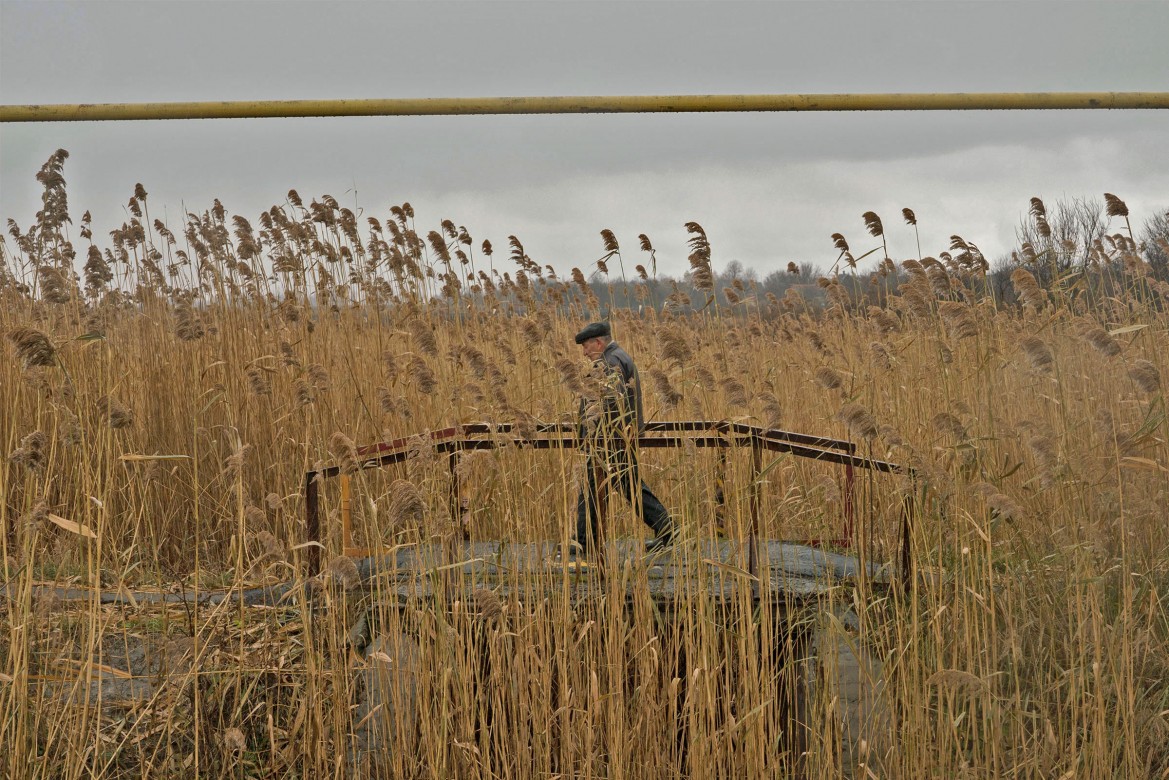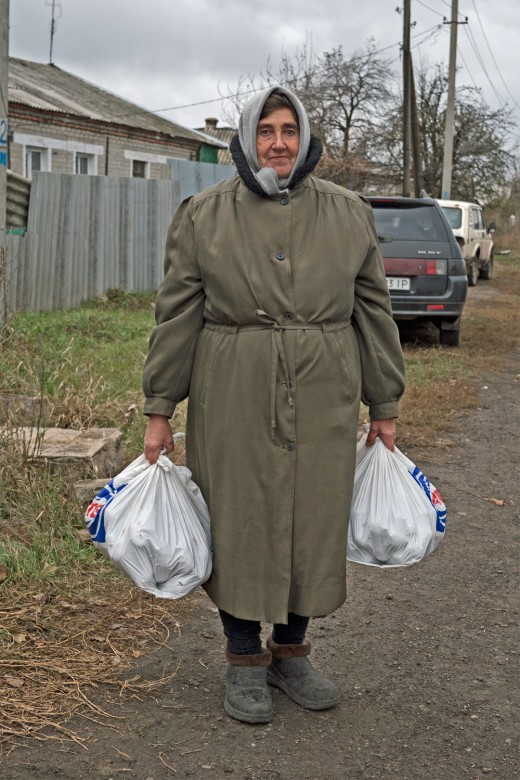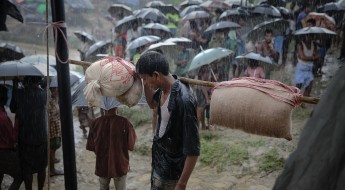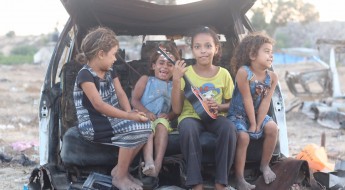Eastern Ukraine: The lasting scars of conflict
 Semenivka, Ukraine, 2016. A car on the main road of the village close to the frontline.What once was 20 min drive, today takes long hours if not even days. Thousands of civilians are travelling through crossing points between government- and non-government controlled territories every day. Movement is not easy. It takes long hours of waiting to cross in the heat or in the cold, often making people to stay there overnight in a hope that they would have an advantage of crossing the next day. The limited mobility severely affects peoples’ lives. It makes access to their property extremely difficult, the healthcare system that used to be unified is today divided along the contact line, making thus a simple visit to a doctor a long journey through the crossing points. Family members rarely decide to take this journey to visit each other, leaving ties among them affected and in some cases even gradually lost.Alessandro Iovino / ICRC
Semenivka, Ukraine, 2016. A car on the main road of the village close to the frontline.What once was 20 min drive, today takes long hours if not even days. Thousands of civilians are travelling through crossing points between government- and non-government controlled territories every day. Movement is not easy. It takes long hours of waiting to cross in the heat or in the cold, often making people to stay there overnight in a hope that they would have an advantage of crossing the next day. The limited mobility severely affects peoples’ lives. It makes access to their property extremely difficult, the healthcare system that used to be unified is today divided along the contact line, making thus a simple visit to a doctor a long journey through the crossing points. Family members rarely decide to take this journey to visit each other, leaving ties among them affected and in some cases even gradually lost.Alessandro Iovino / ICRC Semenivka, Ukraine, 2016. A house destroyed in the fighting.Destroyed houses are common in Donbass. There are villages left completely destroyed, after the most intense battle. The ICRC employs teams of local residents with necessary skills, who have lost their job due to the conflict, to help in reconstruction. In this way, we help fixing damaged buildings and support impoverished people engaging in new income generating opportunities.
Semenivka, Ukraine, 2016. A house destroyed in the fighting.Destroyed houses are common in Donbass. There are villages left completely destroyed, after the most intense battle. The ICRC employs teams of local residents with necessary skills, who have lost their job due to the conflict, to help in reconstruction. In this way, we help fixing damaged buildings and support impoverished people engaging in new income generating opportunities. Toretsk, Ukraine 2016. A spoil tip outside the city that was cut of the water for several days back in November 2016.Toretsk city and its neighborhoods were cut off the water on 22 November 2016, due to the damaged pipeline that has been located nearby the line of contact, leaving approximately 80’000 people without fresh water for days. The ICRC helped a water company team to get safely to the area where the damaged pipe was planted and stood by the workers conducting repairs in this very dangerous area.Alessandro Iovino / ICRC
Toretsk, Ukraine 2016. A spoil tip outside the city that was cut of the water for several days back in November 2016.Toretsk city and its neighborhoods were cut off the water on 22 November 2016, due to the damaged pipeline that has been located nearby the line of contact, leaving approximately 80’000 people without fresh water for days. The ICRC helped a water company team to get safely to the area where the damaged pipe was planted and stood by the workers conducting repairs in this very dangerous area.Alessandro Iovino / ICRC Vodiane, Ukraine, 2016. Kids carrying water in the village.Many schools in eastern Ukraine have been closed or destroyed due of the conflict. Those that are still open remain under the constant risk of shelling. “The most dangerous place is the road to the school,” says the mother of a pupil of a frontline school. “I always walk with my son to the school and bring him back home again. If shooting or shelling starts, I can cover him with my body”.Alessandro Iovino / ICRC
Vodiane, Ukraine, 2016. Kids carrying water in the village.Many schools in eastern Ukraine have been closed or destroyed due of the conflict. Those that are still open remain under the constant risk of shelling. “The most dangerous place is the road to the school,” says the mother of a pupil of a frontline school. “I always walk with my son to the school and bring him back home again. If shooting or shelling starts, I can cover him with my body”.Alessandro Iovino / ICRC Sieverne, Ukraine 2016. A pedestrian crossing a small bridge under a gas pipe.Destructions caused by hostilities as well as lack of maintenance of essential installations is not rare along the line of contact in Eastern Ukraine. Repair teams take important risks to make sure water and gas pipes or electricity lines are back to functioning again. The ICRC stands ready, whenever needed, to act as a neutral intermediary and accompany the repair teams in the area of the contact line.Alessandro Iovino / ICRC
Sieverne, Ukraine 2016. A pedestrian crossing a small bridge under a gas pipe.Destructions caused by hostilities as well as lack of maintenance of essential installations is not rare along the line of contact in Eastern Ukraine. Repair teams take important risks to make sure water and gas pipes or electricity lines are back to functioning again. The ICRC stands ready, whenever needed, to act as a neutral intermediary and accompany the repair teams in the area of the contact line.Alessandro Iovino / ICRC Vodiane, Ukraine, 2016. The woman carrying bread that was provided by the ICRC.Many people in eastern Ukraine live in areas cut off from basic services or functioning markets. Sometimes they do not have access even to the basics of survival - like water, for example. Our teams work alongside most vulnerable people and help them going through these hard times.Alessandro Iovino / ICRC
Vodiane, Ukraine, 2016. The woman carrying bread that was provided by the ICRC.Many people in eastern Ukraine live in areas cut off from basic services or functioning markets. Sometimes they do not have access even to the basics of survival - like water, for example. Our teams work alongside most vulnerable people and help them going through these hard times.Alessandro Iovino / ICRC
Ongoing conflict in eastern Ukraine is leaving lasting scars on people and their livelihoods. Ruined houses, damaged infrastructure, closed schools are among consequences of the hostilities. People living in villages along the contact line struggle through these difficult times enduring under perpetual risk of shelling or mine explosions.
Despite the threat, our teams are dedicated to help communities on both sides of the contact line to survive the conflict and to cope with its lasting consequences.




